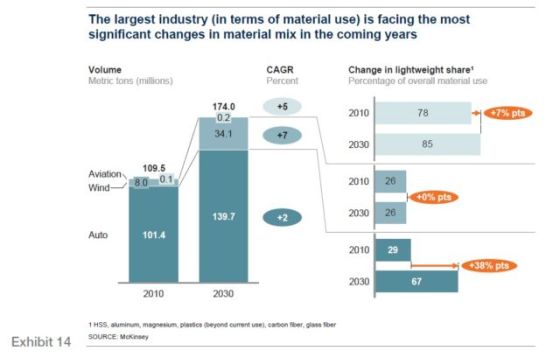
The push to reduce emissions and increase resource efficiency is having a profound effect on automotive manufacture, increasing the demand for lightweight parts and materials – from bodywork through to rivets. But what are the implications for suppliers? Industry expert McKinsey & Company provides its insights…
Of the materials used by automotive, aviation and wind combined, more than 90% is used by the automotive industry. Therefore, changes in materials use are likely to have the most significant impact on the automotive sector. The use of lightweight materials will significantly grow across industries – while the share is currently highest in aviation with almost 80%, automotive is massively increasing lightweight share from 30% to 70% by 2030 (with high strength steel considered as lightweight material).
CO2 emissions targets and correlated penalties have reignited the conversation with an even stronger focus on weight reduction as a lever to minimise fuel consumption. The trend of ever-increasing weight for cars has been curtailed in recent years through the increased use of plastics and improved steel alloys.
The automotive industry will face a significant change in terms of material mix. As a consequence, the overall lightweight market in automotive will increase from €70 to €300 billion, reflecting an annual growth rate of 8%.

Having recognised the significant changes in the material mix, with an overall decrease in ‘normal’ steel and a steep increase in lightweight materials, a number of challenges and opportunities exist for different players. Overall, we assume dynamic changes along the value chain, which might result in significant opportunities but also threats for the affected players. To name some of them:
• SUPPLIERS. Opportunities will arise for suppliers with lightweight competencies to enlarge their product portfolio towards new materials, such as carbon fibre.
• MACHINERY INDUSTRY. The machinery industry will profit from the expected market changes since new production technologies and new tools for lightweight materials (eg. carbon fibre) will be required to reduce current cycle times, thereby creating high demand in the industry.
• BASE MATERIALS. The materials industry will profit due to increasing volumes and prices (eg high-strength steel and aluminium) and new materials suppliers may emerge, mainly in the carbon fibre area, while traditional steel suppliers may experience shrinking revenues if they cannot also deliver high-strength steel.
• OEMS. The effects for OEMs will be twofold: On the one hand, opportunities will arise for OEMs through the possibility of creating new designs and concepts based on the new material, achieving a positive effect on the brand. On the other hand, due to the more expensive material, the OEMs will be directly confronted with a threat to their margins and may have to deal with the additional cost of challenges that cannot be fully anticipated at the moment, such as repair and maintenance. Competence in lightweight thus will be key in future cost competitiveness.
Beyond those concrete examples, interesting questions for the future will evolve: How can suppliers prepare to become part of the new carbon fibre business? Should OEMs integrate vertically to secure core competencies and supplies as it has already been observed in the aviation industry (eg Boeing buying a 50% stake in a joint venture that makes parts for the Dreamliner)? What aftermarket opportunities (particularly recycling) might arise for carbon fibre? We are convinced that the journey towards lightweight has significant potential to change the industry and are excited to be part of this important discussion.
Reprinted with kind permission from McKinsey & Company. Read the full report at www.mckinsey.com or seek further details from McKinsey & Company directly.



